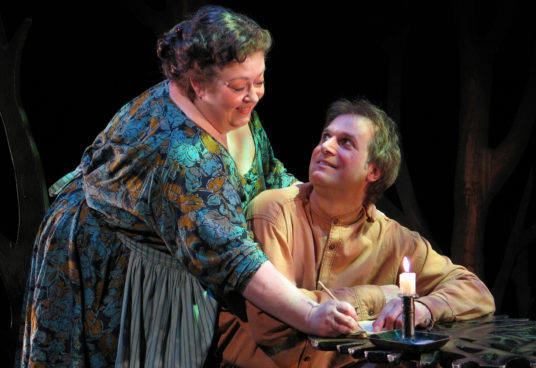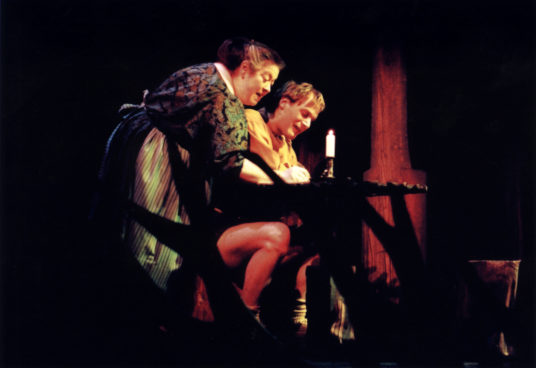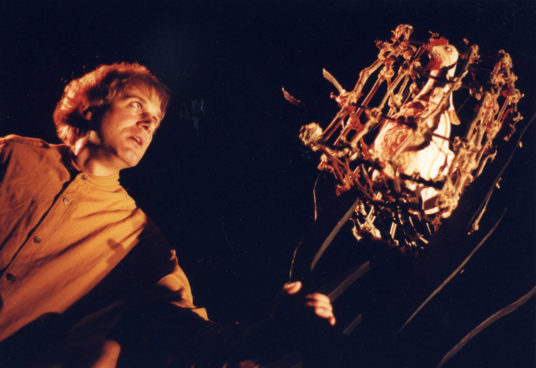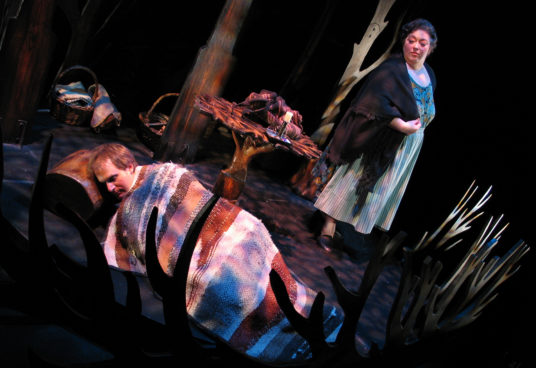The Ogreling
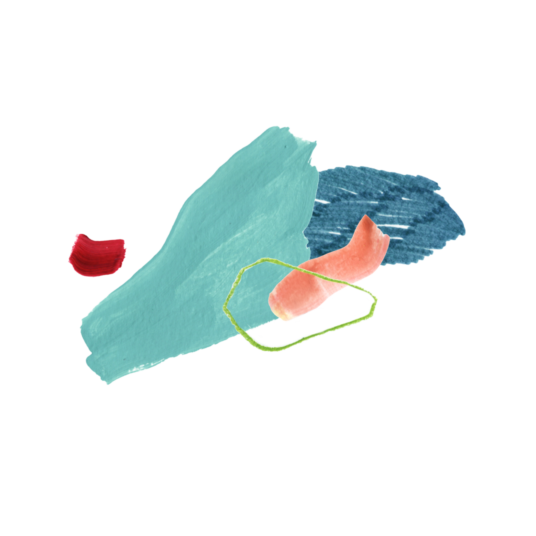
Summary
A house in a thick forest, a school at the end of the road, vegetables day and night, the smell of blood hanging in the air. A careless rooster, the fox and the weasel, a wolf and hunters, children and ogres, an ogre child.
In The Ogreling, the son of an ogre decides to escape his destiny. But first, he must overcome three ordeals, challenges to his instincts and his troubling desires. From his father he inherited an appetite for flesh; but from his mother he received a hunger to live at peace with the world.
We are in the world of fairy tales, and must allow ourselves to be swept along if we are to discover the full richness of the message. Throughout the story of the Ogreling, Suzanne Lebeau explores the never-ending struggle between good and evil that resides within each of us. After all, ogres might not only live in fairy tales …
Text
Suzanne Lebeau
English translation
Shelley Tepperman
Directed by
Gervais Gaudreault
Assistant director and English coach
Robert Vézina
Cast
Mireille Thibault, François Trudel
Set design, costumes, projections and props
Francine Martin
Lighting design
Dominique Gagnon
Sound design
Diane Leboeuf
Hair and make-up
Pierre Lafontaine
Special effects
Éric Gendron
Foot percussion and singing
André Marchand
Pamela’s voice
Léa Forcier-Depatie
Music
Martin Hayes, violin, and Dennis Cahill, guitar
The Lonesome Touch, Green Linnet Records, GL1181
Production manager
Dominique Gagnon
Lighting manager
Carol Lechasseur
In co-production with l’Espace Malraux/Scène Nationale de Chambéry et de la Savoie (France), Le Théâtre/Scène Nationale de Narbonne (France), and le Théâtre du Vieux-Terrebonne (Québec)
Photos in show : Yves Dubé and François-Xavier Gaudreault
“The Suzanne Lebeau-Gervais Gaudreault team has surpassed itself in this troubling yet important play. […] Without the slightest degree of complacency, in a set design of remarkable effectiveness, the play offers intense emotions for young audiences.”
Le Devoir, Montreal
“The audience is spellbound to the end. And until the curtain falls, the young audience reacts, their sagacity sharply honed. And naturally, they are driven by a marked curiosity to witness the real life of an ogre. A highly successful stage direction, expressed within an astonishing forest setting with stylized trees.”
Le Dauphiné Libéré, Chambéry
“With L’Ogrelet, the Québécois team at Le Carrousel offers us its most audacious and beautiful creation. […] Considered today as ‘a leader in theatre for young audiences’ (I feel a need to say all audiences), Le Carrousel once again gives us all we deeply need to live and grow: words of truth, an uncompromising regard, the work of artists and artisans who recognize the power of gestures and who know that it takes light to illuminate that which is hidden within ourselves, a place we often fear to tread. […] All graciously extended through perfect scenography.”
La Savoie, Chambéry
Premiered in French at L’Espace Malraux, Chambéry (France) on October 6, 1997, in co-production with L’Espace Malraux/Scène nationale de Chambéry et de la Savoie (France), Le Théâtre/Scène nationale de Narbonne (France) and le Théâtre du Vieux-Terrebonne (Québec)
The Ogreling
English translation by Shelley Tepperman
Created on June 3, 1998, at the Théâtre d’Aujourd’hui (Montreal, Quebec) as part of the Festival Les Coups de Théâtre
L’Orchetto
Italian translation by Marina Allegri and Alberto Branca
Created on November 18, 1998, at the Teatro al Parco (Parma, Italy) in co-production with Il Teatro delle Briciole as part of the Vetrina Europa festival
El Ogrito
Spanish translation by Cecilia Iris Fasola
Premiered on March 17, 2000, as part of the Teatralia Festival (Madrid, Spain)
Masks of text and lighting design (Académie québécoise du théâtre, 1999)
Teatralia Award (Teatralia Festival, Madrid, Spain, 2000)
| 1997-1998 SEASON : 47 performances – Three international festivals | |
| In France : | Chambéry, Marne-la-Vallée/Biennale Ricochet, Nanterre, Blanquefort, Narbonne |
| In Belgium : | Namur/ Turbulences – Festival international de théâtre jeune public |
| In Quebec : | Terrebonne, Festival Les Coups de théâtre, Théâtre d’Aujourd’hui, Montréal |
| 1998-1999 SEASON : 145 performances – Two international festivals | |
| In Quebec : | Valleyfield, Saint-Georges-de-Beauce, Saint-Jérôme, Terrebonne, Saint-Hyacinthe, Saint-Jean-sur-Richelieu, Longueuil, L’Assomption, (Maison Théâtre) Montréal |
| En Italie : | Festival Vetrina Europa, Parme |
| In France : | Montreuil, Saint-Priest-en-Jarez, Voiron, Bergerac, Seyssinet, Caluire et Cuire, Villefranche, Saint-Chamond, Roanne, Albertville, Reims/Festival Méli’Môme, Homécourt, Ivry, Vileneuve-sur-Lot, Le Havre, Quimper, Flers, Alençon. |
| In Switzerland : | Genève. |
| 1999-2000 SEASON : 103 performances – Four international festivals | |
| In France : | Rungis, Tremblay-en-France, Trappes, Annecy, Albi, Manosque, Château Arnoux, Ibos-Tarbes, Foix, Blanquefort, Lormont, Saint-Valéry-en-Caux, Vitry-le-François, Noisy-le-Grand, Douai/Festival Les Météores |
| In Spain : | Festival Teatralia, Madrid |
| In Mexico : | Festival Centro Histórico de Mexico |
| In Quebec : | Shawinigan, Saint-Jean-sur-Richelieu, Montréal, L’Assomption, Sainte-Thérèse |
| In Canada : | Centre National des Arts, Ottawa, London International Children’s Festival, London |
| 2000-2001 SEASON : 73 performances | |
| In Quebec : | Mont-Laurier, Québec, Beloeil, Ahuntsic, Joliette |
| Off CINARS : Maison de la culture Mercier, Montréal | |
| In France : | La-Roche-sur-Yon, Le-Blanc-Mesnil, Neuves-Maisons, Maurepas, Rezé, Clamart, St-Michel-sur-Orge, Limoges, Annemasse, La Ricamarie, Villard-Bonnot, Épinay-sur-Seine, Arras |
| 2001-2002 SEASON : 4 performances – One international festival | |
| In Mexico : | Festival Telón Abierto, Aguascalientes |
| 2002-2003 SEASON : 20 performances | |
| In Mexico : | León, Guanajuato, Morelia, Zacatecas, Guadalajara, Tepic, Colima, Querétaro, San Luis Potosí, Aguascalientes, México |
| 2003-2004 SEASON : 32 performances – One international festival | |
| In Mexico : | Festival Cultural del Barrio Antiguo, Monterrey |
| In Quebec : | Maison Théâtre – Montréal. |
| 2004-2005 SEASON : 36 performances – Three international festivals | |
| In Argentina : | Festival internacional de teatro para niños y jovenes, Córdoba |
| In Quebec : | Laval, Gatineau (Festival international des arts pour la jeunesse d’Ottawa), Trois-Rivières, Québec, Valleyfield. À Montréal : Arrondissements de Lachine, LaSalle, Montréal-Nord, Saint-Laurent et Sainte-Geneviève ainsi que les Maisons de la culture Frontenac et Maisonneuve (Festival Petits bonheurs) |
| 2005-2006 SEASON : 6 performances | |
| In Mexico : | Chetumal, Mérida, Campeche, Villahermosa, Tuxtla Gutiérrez, Veracruz. |
Publications :
In French : Lanctôt Éditeur (Québec) 1997 and chez Théâtrales (France) 2003. In Spanish : Bajo la luna (Argentina), 2004; El Milagro Ediciones (México), 2003; and Paso de Gato (México), July/August 2002.
La forêt s’expose
Exposition en arts visuels présentée à Montréal par le Carrousel en collaboration avec la Maison Théâtre, du 21 octobre au 8 novembre 1998 dans le hall et les foyers de la Maison Théâtre. L’exposition a été reprise à Mont-Laurier à l’automne 2001.
Commissaire : Gervais Gaudreault
assisté de Francine Martin en 1998 et de Jean-Jacques Ringuette en 2001.

LES ARTISTES | LA DISCIPLINE | LE TITRE
Claude-Philippe Benoit | Photographie | Voûte fanée / Chapître Ô-Nu.
Sylvie Bouchard | Peinture | Paysage inversé : l’enracinement du ciel.
Guy Bourassa | Sculpture | Ombres.
Lise-Hélène Larin | Installation | L’arbre est dans ses feuilles.
Francine Larivée | Installation | Transparente légèreté. Dérive des courants.
Gilles Mihalcean | Sculpture | La forêt.
Monique Mongeau | Peinture sur bois | L’herbier.
Roberto Pellegrinuzzi | Photographie | Le chasseur d’images.
Michel Saulnier | Sculpture sur bois | Prends-moi la nuit #1.
Artiste de la région invitée à Mont-Laurier : Angèle Cornu.
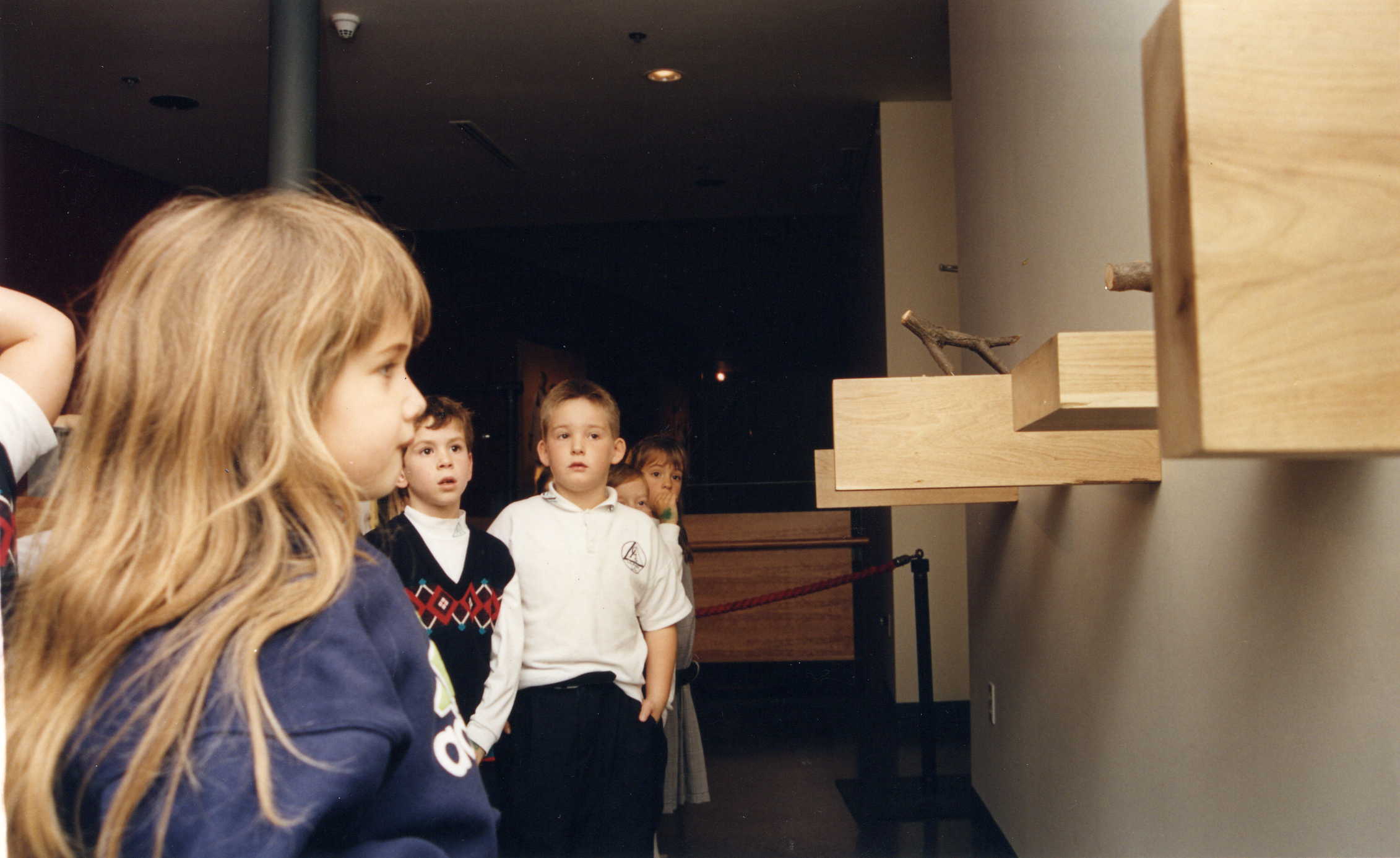
Ombres (1996), Guy Bourassa – Bois de noyer et brindilles de bois, 5 éléments, 20 cm X 10 cm X 46 cm chacun.
Depuis toujours, la forêt fascine, attire, effraie. Elle porte nos envies d’explorer, notre soif de nous trouver tout en nous perdant, et demeure le lieu des rencontres inattendues, parfois troublantes, toujours révélatrices de ce que nous avons de plus intime.
Tout au long de la création du spectacle L’Ogrelet, la forêt a été source des interprétations les plus personnelles et les plus originales : elle nous a littéralement fascinés. Cette fascination, j’en ai retrouvé l’écho chez de nombreux artistes du Québec, qui nourrissent et inspirent mon travail ainsi que celui de la scénographe Francine Martin. Nous avons voulu la partager avec le public, enfants et adultes, et lui donner l’occasion d’allier, en une seule sortie, plaisir du théâtre et des arts visuels. C’est de ce désir qu’est né le projet La forêt s’expose.
Les enfants ont rarement la chance de rencontrer l’art contemporain. Pourtant, ils sont à l’âge de la disponibilité la plus grande et ils n’ont pas de préjugés sur ce que doit être l’art… C’est aussi sans préjugés que tous les artistes ont répondu à mon invitation, avec enthousiasme, générosité, passion et engagement. Je les en remercie chaleureusement, ainsi que tous ceux et celles qui nous ont soutenus dans cette belle aventure.
Au public, je souhaite une agréable promenade…
Gervais Gaudreault
À LA MAISON THÉÂTRE EN 1998 :

En avant-plan : Prends-moi la nuit #1 (1992), Michel Saulnier – Pigments de couleur, pâte de bois, huile de tung et cèdre. En arrière-plan : L’herbier, extrait(1993-1997), Monique Mongeau – Huile et cire sur panneaux de merisier, 15 panneaux de 38 cm X 56 cm chacun.
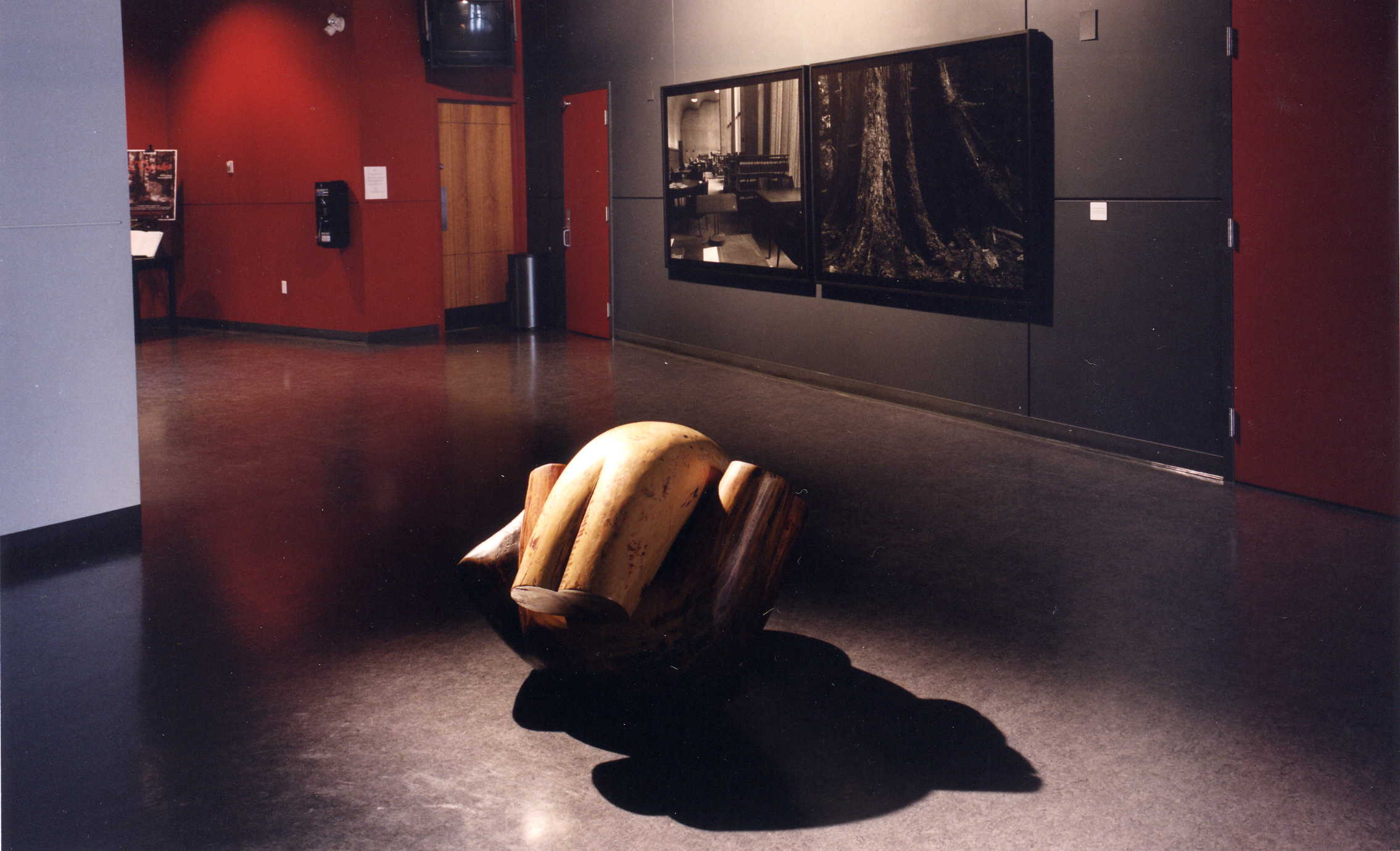
En avant-plan : Prends-moi la nuit #1 (1992), Michel Saulnier – Pigments de couleur, pâte de bois, huile de tung et cèdre. En arrière-plan : Voûte fanée, Chapitre Ô-Nu (1992), Claude-Philippe Benoit – Diptyque, deux épreuves argentiques encadrées, 138 cm X 195 cm chacune.

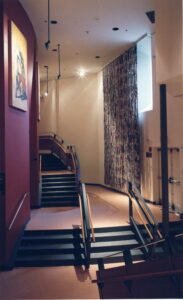
À gauche : La forêt (1995), Gilles Mihalcean – Plâtre et plâtre peint, bois, corde et plomb 5,18 m X 158,8 cm X 119,4 cm. En arrière-plan : Paysage inversé : l’enracinement du ciel (1990), Sylvie Bouchard – Aquarelle sur bois, 120 cm X 90 cm (Collection Banque Nationale). À droite : L’arbre est dans ses feuilles (1998), Lise-Hélène Larin – Le Devoir, La Presse, Le Soleil, The Gazette, The Globe and Mail, The New York Times (semaines du 21 septembre au 19 octobre 1998) et élastiques #14. 3,6 m X 6 m X 5 cm. Son : feuilles dans le vent.

À gauche : Le chasseur d’images (1993), Roberto Pellegrinuzzi – Épreuves argentiques, carton, cadres et épingles à spécimens 195 cm X 560 cm X 10 cm. À droite : Transparente légèreté. Dérive des courants (1998), Francine Larivée – 48 bocaux de verre, ossements, transparents plastifiés et textes.
À MONT-LAURIER EN 2001 :

Ombres (1996), Guy Bourassa – Bois de noyer et brindilles de bois, 5 éléments, 20 cm X 10 cm X 46 cm chacun.

Titre inconnu, Angèle Cornu.
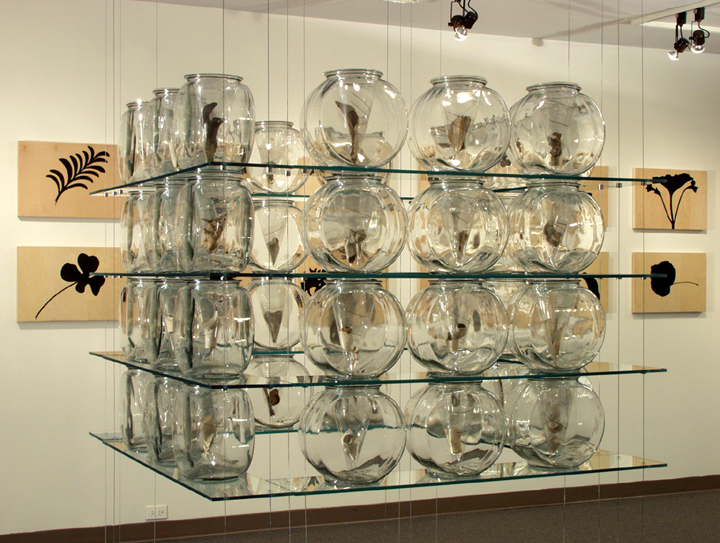
Transparente légèreté, dérive des courants (1998), Francine Larivée – 48 bocaux de verre, ossements, transparents plastifiés et textes.
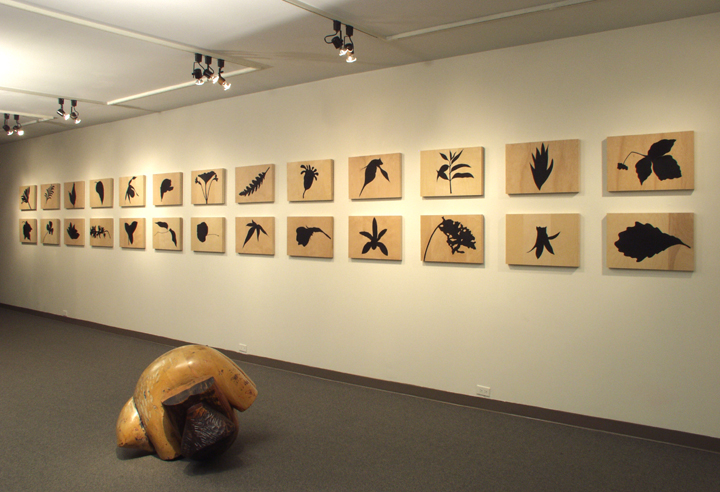
En avant-plan : Prends-moi la nuit #1 (1992), Michel Saulnier – Pigments de couleur, pâte de bois, huile de tung et cèdre.
En arrière-plan : L’herbier (1993-1997), Monique Mongeau – Huile et cire sur panneaux de merisier, 24 panneaux de 38 cm X 56 cm chacun

La forêt (1995), Gilles Mihalcean – Plâtre et plâtre peint, bois, corde et plomb 5,18 m X 158,8 cm X 119,4 cm.
Photographies de Daniel Roussel (Maison Théâtre) et Lucien Lisabelle (Mont-Laurier).

